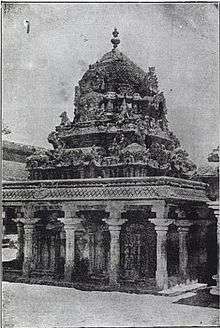Uthrapathiswaraswamy Temple
| Uthrapathiswaraswamy Temple | |
|---|---|
 Central shrine | |
| Geography | |
| Coordinates | 10°51′48″N 79°43′20″E / 10.86333°N 79.72222°ECoordinates: 10°51′48″N 79°43′20″E / 10.86333°N 79.72222°E |
| Country | India |
| State | Tamil Nadu |
| District | Nagapattinam |
| Location | Thiruchengattankudi |
| Culture | |
| Primary deity | Shiva, Ganesha |
| Architecture | |
| Architectural styles | Dravidian |
Uthrapathiswaraswamy Temple is a Hindu temple in Tiruchenkattankudi in Nagapattinam district in the Tamil Nadu state of India. Though it is dedicated to the Hindu god Shiva, it is more famous for its Ganesha (Ganapati) icons.[1] The main Ganesha shrine depicts him with a human head, instead of the elephant head he is usually depicted with.[1] Vatapi Ganapati, the other Ganesha icon, was installed in a smaller shrine at a later date, though has .
Names and legend
The Shiva temple was known as Siruthonda Ganapatishvara, named over Siruthondar. The name "Ganapatishvara", which also gives the town his alternate name "Ganapatishvaram", denotes Shiva as "Lord of Ganesha" and alludes to the legend that Ganesha killed a demon called Gajamukhasura and then worshipped his father Shiva here.[1][2][3]
Vatapi Ganapati
The icon of Vatapi Ganapati is currently enshrined in a secondary shrine in the temple complex of Uthrapathiswaraswamy Temple. As per oral tradition, the icon of Vatapi Ganapati was brought booty from the Chalukyan capital of Vatapi (presently known as Badami in northern Karnataka) by Paranjothi, the commander-in-chief of the Pallava king Narasimhavarman I (reign: 630–668 CE), following the conquest of Pallavas over the Chalukyas (642 CE). The icon was placed in Paranjothi's birthplace Tiruchenkattankudi. Later, Paranjothi renounced his violent ways and became a Shaiva monk known as Siruthondar, is venerated as a Nayanar saint today.[2][3] However, no written records substantiate the oral tradition; the Ganesha icon is missing from list of war booty brought by the Pallava general.[2] The famous Vatapi Ganapatim hymn is dedicated to this icon.
Gallery
 Vatapi Ganapati
Vatapi Ganapati Temple structure
Temple structure
Notes
References
- Brown, Robert L. (1991). Ganesh: studies of an Asian god. New York: State University of New York Press. pp. 143–162. ISBN 978-0-7914-0656-4. Retrieved 2 August 2009.
- Ayyar, P. V. Jagadisa (1993). South Indian Shrines. New Delhi: Asian Educational Services. pp. 402–404. ISBN 978-81-206-0151-2. Retrieved 2 August 2009.
- Tourist Guide to South India. Chennai: Sura Books. 2006. pp. 58–59. ISBN 978-81-7478-175-8. Retrieved 2 August 2009.
